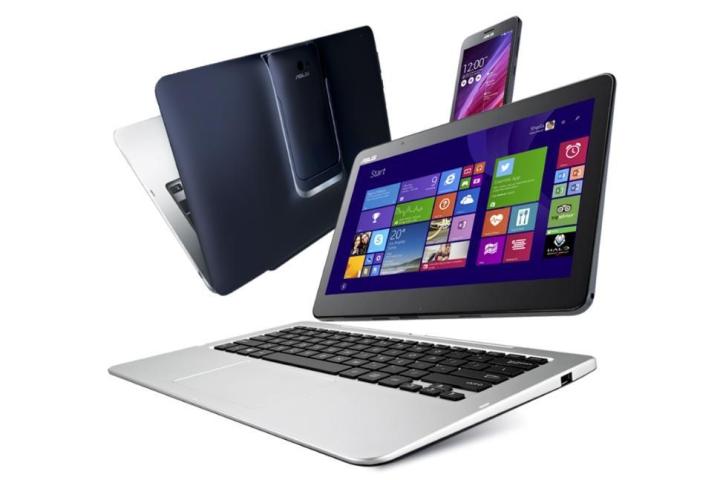
On the PC front, two of the biggest announcements out of this year’s Computex show in Taipei provide proof that PC makers are still flailing wildly to find relevance in a world increasingly dominated by iPads, Android, and Chromebooks.
First up was the Asus Transformer Book V, a contraption that has a 5-inch Android smartphone sliding inside a 12.5-inch tablet that runs Android and Windows. Then that PadPhone-like device-in-a-device clicks into a keyboard dock with its own Intel Core processor and battery, making for one device that runs multiple separate operating systems. Just the thought of managing such a device makes me dizzy, and I do this for a living.
And that’s not even getting at the potential hardware issues with the Transformer Book V. If you’ve owned a TV/VCR/DVD combo, you probably remember why it’s a bad idea to conjoin three technologies together. The short version: If one part breaks, you’ll have to send your phone, tablet, and laptop in for repair. And one of the pieces (likely the phone) will become frustratingly obsolete before you’re ready to upgrade the rest.
Next up to the Computex crazy plate was Toshiba’s Kirabook L93, a convertible that’s a bit like Lenovo’s simple-to-understand Yoga, but with a removable keyboard, no touchpad, and a ridiculous amount of versatility that, really, no one is asking for. The thing folds and flips into seven different modes.
News flash to product designers: Once your device has gone beyond three modes, you’ve hopelessly lost the attention of the mainstream consumer. But then again, the Kirabook L93 isn’t aimed at the mainstream, anyway. It’s going to be Japan only, at least for now, and its price is said to be in the neighborhood of $2,600 US dollars. We’re sure there are a few executives out there willing to splurge on something like this. Beyond those few, I don’t know many people who are looking to buy a laptop or a convertible at even half that price.
Don’t expect the convertible craziness to stop anytime soon, either. According to Cnet’s coverage of Intel’s Computex keynote, there are “three times the volume of new [hybrid] designs in the pipeline compared with a year ago,” and half are expected “to hit mainstream price points below $700.” That’s good news on the pricing front.
But as our own Matt Smith recently pointed out, convertibles have fundamental flaws that PC makers don’t seem to be addressing. The ideal size for a laptop screen for productivity use is somewhere north of 12 inches (especially if the resolution is 1080p or higher). The ideal screen size for a tablet for media consumption and apps is somewhere between 7 and 10 inches. And while Samsung and others have made progress with flexible screens, we’re a long way from screens that can physically grow and shrink to fit changing needs.
So what should PC makers do to attract new customers? Stop chasing the myth of the perfect convertible. Decent Android tablets are now approaching the $100 mark. They’re approaching impulse-buy territory, and are showing no signs of slowing in their ability to get cheaper and better. So it’s becoming increasingly unclear why most consumers (if not nearly all of them) would want to pay extra for a convertible that’s, at best, pretty good as a laptop, and large and heavy as a tablet—to say nothing of the lack of good touch-centric Windows 8 apps and games.
Instead, I’d like to see PC makers seize on Intel’s announcement of the low-wattage Core M processor (which they showed off in a fanless tablet prototype tablet that’s thinner than an iPad Air) and put it in a really good, affordable laptop.
Imagine a fanless laptop with a 1080p, 13-inch screen, and enough CPU power to handle Photoshop and other medium-duty productivity tasks. Imagine that this laptop is close to half-an-inch thick, gets 12 hours of battery life, and comes in under the $700 mark that Intel is touting for upcoming convertibles. I’d take that, and the next Nexus tablet, over a 2-in-1 Windows device any day, and it should be possible with Intel’s new chips.
I also think there will be plenty of people who, after ditching their laptops for tablets and convertibles, will soon find themselves severely missing the much-better typing experience that a good laptop provides. And the Surface Pro 3, while much improved, is still a far cry from that, no matter what the Surface die-hards say.
Those customers who bought a tablet or an early convertible and found them disappointing may stick with them for a while—maybe even for a couple of years in this sluggish economy. But eventually, many are going to be looking to buy a traditional laptop again. If PC makers have truly compelling options that are affordable when that wave hits, they could recoup some of the customers that they lost to Android, iOS, and Chrome OS.
If not, the bulk of those potential customers will likely buy a Macbook Air. The Air’s design may be stale, but it’s getting cheaper and cheaper, while the best Ultrabooks are still north of $1,000.
Editors' Recommendations
- Don’t miss these last-minute Mother’s Day sales with delivery before May 10
- Don’t call it retro. Atari’s VCS is a modern console for PC gamers


